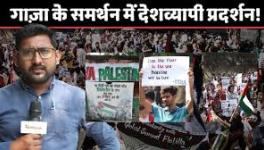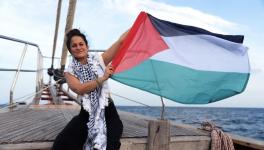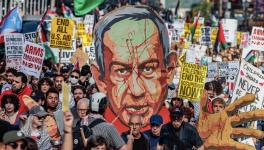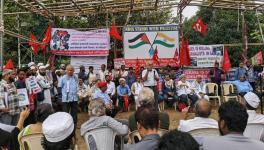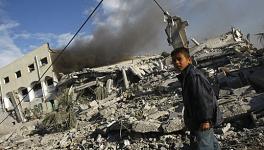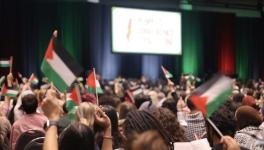Art is Political: Phil Garip on Censorship of Pro-Palestine Art
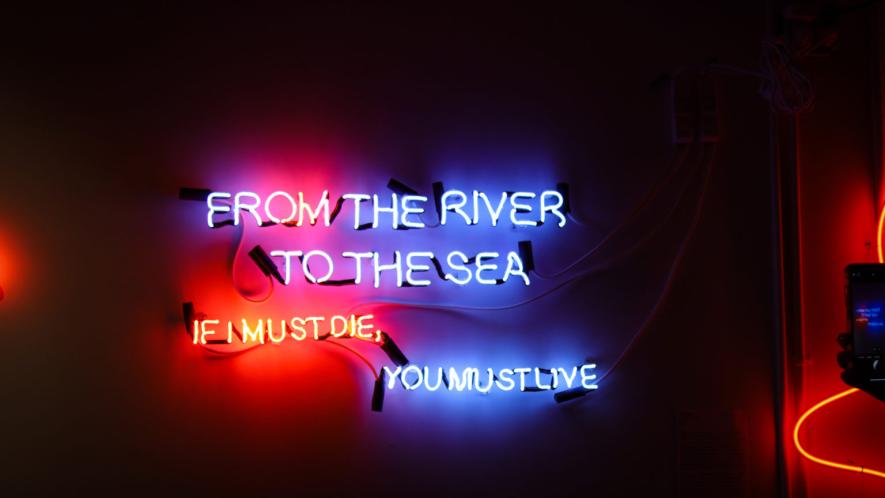
Palestinian-American artist Phil Garip's piece was pulled out of an UrbanGlass exhibit for the use of the slogan "from the river to the sea" (Photo via the People's Forum)
On March 6, the People’s Forum in New York City opened the exhibition of “Fundamental Particles,” showcasing artworks by 17 artists who had their works pulled from their original exhibition at UrbanGlass, a leading glass-blowing facility in Brooklyn, as a result of one of the featured works’ themes in solidarity with Palestine—a piece by Palestinian-American artist Phil Garip.
16 artists had pulled their works from the UrbanGlass exhibition after a neon piece by Garip was excluded. This piece features the well-known slogan for Palestinian liberation “FROM THE RIVER TO THE SEA” and a line from martyr Refaat Alareer’s last poem before he was assassinated by Israel: “IF I MUST DIE, YOU MUST LIVE”.
Garip was called in to a meeting with the executive director and a member of the curatorial staff of UrbanGlass, who asked Garip to remove the phrase “from the river to the sea,” associating the popular slogan with the Palestinian resistance group Hamas. “That was sort of the only context with which they were engaging with the phrase. And that’s obviously incredibly frustrating,” Garip told Peoples Dispatch.
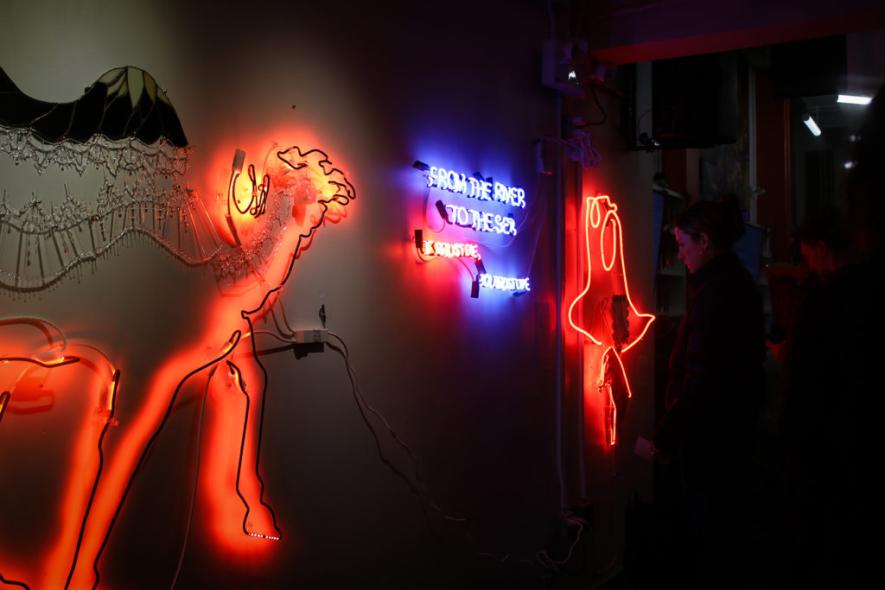
Garip’s piece as exhibited at the People’s Forum in New York City (Photo via the People’s Forum)
Garip was asked to remove that phrase from his piece, which he refused to do. Following a decision by the executive committee of UrbanGlass, the piece was removed from the exhibit.
Garip took to social media to express his frustration with the blatant act of censorship. “Despite sending a mockup ahead of the work ever being made, and sharing an artist statement that explained my intent, I was never invited to speak on the board… No one who took issue with the piece approached me directly.” Garip wrote in an Instagram post on March 2, a few days after he was informed that the executive committee had voted to exclude his piece. “The widespread suppression of [from the river to the sea] in western media echoes a greater suppression of Palestinian liberation efforts as a whole.”
Garip then asked his fellow artists in the exhibit to remove their artworks in solidarity, which the vast majority of them did. The exhibit was then rehoused at the People’s Forum, a left-wing movement space in Manhattan.
Peoples Dispatch spoke to Garip about the significance of artists making art about the Palestinian struggle:
Peoples Dispatch: What was it like to see your fellow artists pull out of the UrbanGlass exhibition in solidarity?
Phil Garip: It was really touching. I was just really grateful that they were on my team. And I wasn’t surprised either. That’s the hard truth about this whole situation is that the people who are going to who are putting the most on the line by doing things like this are the ones who get paid the least and work the most for the organization [UrbanGlass], who I work with every day. And they’ve been supportive the whole time.
PD: What moved you to center your piece around the Palestinian struggle for land, and Refaat Alareer in particular?
PG: I wanted to marry those two things as at least insofar as Alareer’s poem is calling for Palestinian stories to continue being told. I found that to be a very moving sentiment, especially as we’re seeing so many Palestinian stories being erased and ignored and disregarded.
I thought his story in general was pretty emblematic of the Palestinian experience. The experience, at least in my view, that the voice matter doesn’t matter enough to save the life.
I had this platform presented to me by the show and I couldn’t think of another thing that I wanted to use that platform for other than Palestinian life.
As an artist, my work has not engaged with Palestine. As a Palestinian, I’ve been engaged with Palestine. Previously, I couldn’t figure out a way to engage with the conflict and with everything going on there in a way that was appropriate for me, as I’m also an American. I grew up in New Jersey. My father was born here, so I didn’t know, until this moment, I didn’t see a lane for me. I regret that a little bit. I think there are always plenty of ways to engage. But yeah, the time for this work was years ago and it came to me now.
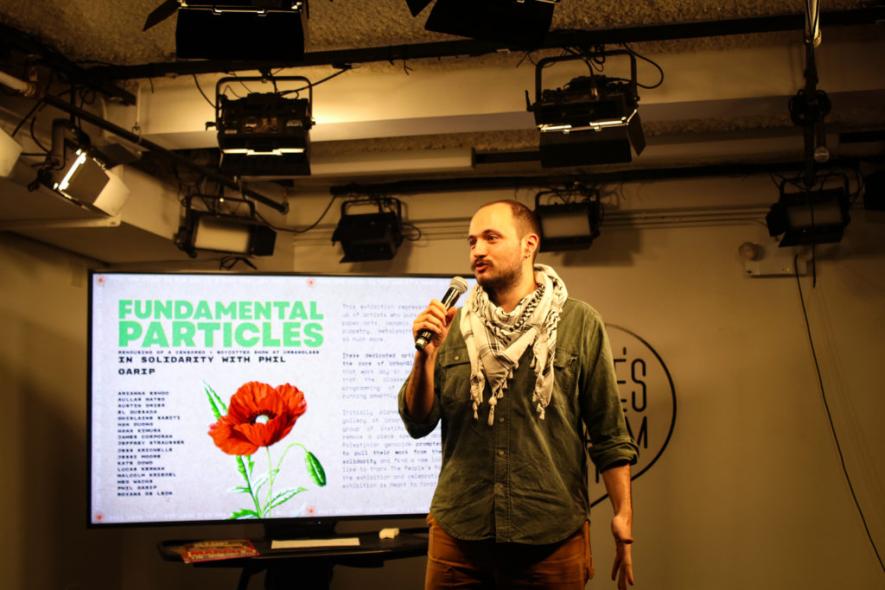
Phil Garip gives a talk at the People’s Forum (Photo: the People’s Forum)
I want to make sure that we’re centering the conflict and the loss of life there before anything else because it’s so devastating. It’s just horrible. I think as artists, we have a responsibility to engage politically and especially in moments like this, when the situation can seem so lost or dire, like there’s no option.
I’ve been reading a lot of Edward Said, and he speaks a lot about how art is political, whether it’s engaged with or not. And I, I just don’t think we have a choice at this moment, but to engage.
PD: How do you believe other artists must continue to show solidarity with Palestine? What sort of solidarity would you like to see from other artists?
PG: The glass community has really shown up in this way, but as far as what artists can do, I think there’s a huge opportunity now to challenge the institutions that were part of and and investigate where those loyalties lie.
If you have a platform, I think you have a responsibility to use it to speak politically, especially for those people who can’t do it themselves. I’d like to see that, if it feels safe for artists to do so in their respective mediums, in their respective institutions, to make political work and make work that is going to be “controversial” because what else can we do?
Art can feel frivolous. And I think this is a moment when it’s not.
Get the latest reports & analysis with people's perspective on Protests, movements & deep analytical videos, discussions of the current affairs in your Telegram app. Subscribe to NewsClick's Telegram channel & get Real-Time updates on stories, as they get published on our website.










